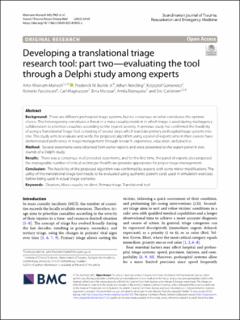| dc.contributor.author | Khorram-Manesh, Amir | |
| dc.contributor.author | Burkle, Frederick M. | |
| dc.contributor.author | Nordling, Johan | |
| dc.contributor.author | Goniewicz, Krzysztof | |
| dc.contributor.author | Faccincani, Roberto | |
| dc.contributor.author | Magnusson, Carl | |
| dc.contributor.author | Merzaai, Bina | |
| dc.contributor.author | Ratnayake, Amila | |
| dc.contributor.author | Carlström, Eric | |
| dc.date.accessioned | 2023-05-05T08:34:55Z | |
| dc.date.available | 2023-05-05T08:34:55Z | |
| dc.date.created | 2022-09-21T13:49:28Z | |
| dc.date.issued | 2022 | |
| dc.identifier.citation | Khorram-Manesh, A., Burkle, F. M., Nordling, J., Goniewicz, K., Faccincani, R., Magnusson, C., Merzaai, B., Ratnayake, A. & Carlström, E. (2022). Developing a translational triage research tool: part two—evaluating the tool through a Delphi study among experts. Scandinavian Journal of Trauma, Resuscitation and Emergency Medicine, 30, Artikkel 48. | en_US |
| dc.identifier.issn | 1757-7241 | |
| dc.identifier.uri | https://hdl.handle.net/11250/3066383 | |
| dc.description.abstract | Background: There are different prehospital triage systems, but no consensus on what constitutes the optimal choice. This heterogeneity constitutes a threat in a mass casualty incident in which triage is used during multiagency collaboration to prioritize casualties according to the injuries’ severity. A previous study has confirmed the feasibility of using a Translational Triage Tool consisting of several steps which translate primary prehospital triage systems into one. This study aims to evaluate and verify the proposed algorithm using a panel of experts who in their careers have demonstrated proficiency in triage management through research, experience, education, and practice.
Method: Several statements were obtained from earlier reports and were presented to the expert panel in two rounds of a Delphi study.
Results: There was a consensus in all provided statements, and for the first time, the panel of experts also proposed the manageable number of critical victims per healthcare provider appropriate for proper triage management.
Conclusion: The feasibility of the proposed algorithm was confirmed by experts with some minor modifications. The utility of the translational triage tool needs to be evaluated using authentic patient cards used in simulation exercises before being used in actual triage scenarios. | en_US |
| dc.language.iso | eng | en_US |
| dc.rights | Navngivelse 4.0 Internasjonal | * |
| dc.rights.uri | http://creativecommons.org/licenses/by/4.0/deed.no | * |
| dc.title | Developing a translational triage research tool: part two-evaluating the tool through a Delphi study among experts | en_US |
| dc.type | Peer reviewed | en_US |
| dc.type | Journal article | en_US |
| dc.description.version | publishedVersion | en_US |
| dc.rights.holder | © The Author(s) 2022. | en_US |
| dc.source.volume | 30 | en_US |
| dc.source.journal | Scandinavian Journal of Trauma, Resuscitation and Emergency Medicine | en_US |
| dc.identifier.doi | https://doi.org/10.1186/s13049-022-01035-z | |
| dc.identifier.cristin | 2053948 | |
| dc.source.articlenumber | 48 | en_US |
| cristin.ispublished | true | |
| cristin.fulltext | original | |
| cristin.qualitycode | 1 | |

